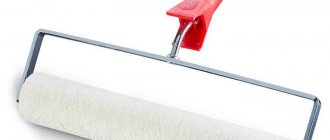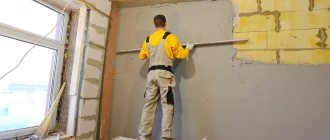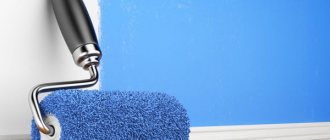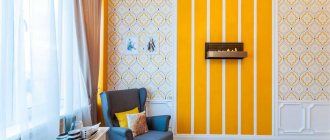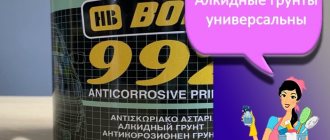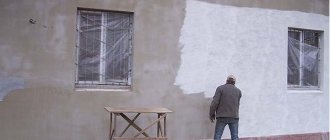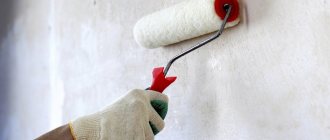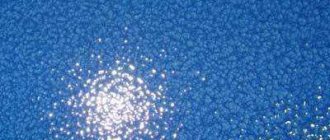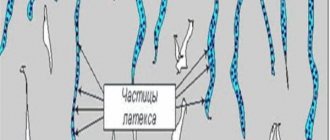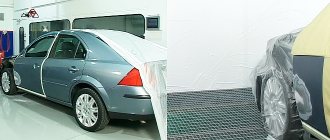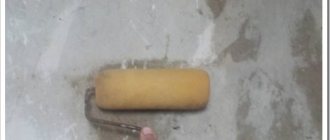Features of restoration of varnished parquet
When carrying out renovations, there is often a need to renew an old parquet floor that has a varnish coating. Can I use acrylic primer over old paint? Is it possible to varnish previously used varnish?
I guess, yes
It is important to clarify what kind of varnish the floor was previously coated with. If you used a water-based varnish, then this should be used.
Polymer compositions and nitro varnishes can be renewed with any paint and varnish substances, including water-based ones. But still, whether it is possible to varnish the varnish should be checked with a specialist in each specific case.
Acidic soil
This primer is also called phosphating, reactive, etching.
Essentially it is a mixture of phosphoric acid and zinc. To be more precise, the composition contains polyvinyl butyral (a synthetic polymer with good adhesive and film-forming properties), zinc phosphates and chromates, alcohol, phosphoric acid (a good rust converter), and water.
Acidic soil
The principle of operation is approximately the same: phosphoric acid acts on the metal, and zinc is also deposited. Polyvinyl butyral, which is part of the reactive primer, forms a film on which the next layer of acrylic primer will adhere well. This results in a thin layer of adhesive and anti-corrosion coating. This primer does not remove rust, but does not allow it to spread.
Using acid soil
It is the primary soil. Sprayed onto bare metal. It is very important to properly degrease the surface before spraying. The presence of corrosion residues is acceptable. Only one thin layer is applied. Dries quite quickly, about 10-15 minutes at 20 degrees Celsius. After drying, you need to cover it with leveling acrylic primer. Then, if necessary, we putty, but you can’t do it right away on acidic soil.
The etching primer does not need to be sanded before spraying the leveling primer.
You can read more about this soil in another article.
What happens if you apply acid primer to putty and old paintwork?
As already written above, the acid primer is sprayed onto clean metal, but it is also allowed to come into contact with putty. If it comes into contact with old paintwork or acrylic primer, outlining may appear in the future. That is, upon subsequent priming with acrylic filler primer, the outline of the old primer will appear. This is due to the etching primer penetrating under the edges of the old coating. Therefore, it is still recommended to apply phosphating primer to bare metal, and if there are old coatings, use epoxy primer.
So what kind of soil should you use and when should you use it?
If the metal is clean and not rusty, then you can use epoxy primer. Also, if there are remnants of old paintwork, primer and putty, it is better to use epoxy primer. If there are doubts about the compatibility of the old with the new coating, then it is better to also apply this primer as an insulating layer.
If there are traces of corrosion on the metal, it is better to use an acid primer. Just first you need to clean the metal as much as possible from rust, and the etching primer will transform the remaining corrosion and stop it from spreading. Again, clean metal, without traces of corrosion, can be primed with acid primer, followed by the application of acrylic primer.
Is it possible to use both primers at the same time?
Some people believe that by priming with acid primer first and then spraying with epoxy primer they will get maximum protection for the metal. But in fact, epoxy primer neutralizes the properties of the etching primer by affecting it with its solvent. Therefore, you need to choose one primer for use in a particular case. The issue of “applying epoxy primer to an acidic one” is discussed in more detail in the article “Is it possible to apply epoxy primer to an acidic one?”
What is the difference between acid primer and epoxy primer?
Epoxy primer is a substance that includes epoxy resin, fillers, polymers, and some alcohol derivatives. The primer, after application, creates a film that does not allow oxygen to pass through. After hardening, the soil does not allow water to penetrate at all, since it does not form pores. Epoxy primer is available in a can or in jars.
Epoxy primer in cans Source sevparitet.ru
Epoxy Primer Differences
According to experts, epoxy primer should be applied directly to clean metal and then putty. This is especially important if the metal is being restored over several weeks, i.e. for a long time.
For example, if a car sits in a garage for a long time, then, since there is humidity in the room, the areas of the body that have been stripped down to metal will begin to oxidize. In this case, you can choose the option of puttying with an epoxy primer. Then the putty should be applied before the primer has completely hardened.
Differences in acid soil
When it comes to acidic soil, you can hear the following names: phosphating, etching, reactive. The primer in this embodiment is a compound of zinc and phosphoric acid. More precisely, it consists of:
- polyvinyl butyral, which is a synthetic material and serves to form good adhesion and film;
- zinc phosphates and chromates;
- water;
- phosphoric acid, which is an excellent rust converter;
- alcohol.
Composition of acidic soil Source strport.ru
The operating principle is approximately this: phosphoric acid acts on the metal and, at the same time, zinc is precipitated. The film is formed by polyvinyl butyral - the acrylic layer will already adhere tightly to it. After applying the primer to the metal surface, a thin coating is obtained. It is an anti-corrosion and adhesive layer. The primer does not completely destroy the rust that is already there, but it also does not allow it to spread.
Acid primer for cars is divided into four main types:
- One-component.
Acid primer is often sold in a can to make processing easier. You can also use a can of primer to spray it with a spray gun. The composition does not need to be prepared - it can be used immediately. When the soil hardens, you can begin to treat it with an acrylic composition to which a hardener has been added.
- Two-component.
If you purchase a two-component primer, you must prepare a primer. To do this, it is mixed with an activator, and the consistency can be different - hard or soft.
Two-component primer Source autocosmetica.by
See also: Catalog of companies that specialize in paints and varnishes.
Professionals prefer to work with a solid form, as it gives the strongest film. Depending on the recommendations in the instructions, the two-component composition can be applied in 1, 2, 3 layers. During treatment, maintain an interval of approximately 5 minutes between applications.
- Reactive.
This option is used for clean surfaces. The reactive substance forms a very small layer (8-13 microns). This is the base on which the following layers should be applied.
- Self-Etching primer.
This substance is a soil with the addition of zinc. Used to eliminate unevenness and improve the quality of adhesion. The substance acts on the metal, resulting in the creation of a layer of frozen polymer elements.
Self-Etching primer Source alicdn.com
You can choose a one- or two-component primer, but most craftsmen use a material that has two ingredients. The greatest wear resistance is achieved through filler primer - this is a necessary stage of coating.
Some tricks for working with aerosol primer
In construction or repair work, sometimes you have to deal with very rusty metal surfaces. But few people know that it is not at all necessary to completely clean them; it is enough to remove fragile fragments of rusty scabs with sandpaper, which may fall off during further work. After this step, it is possible to apply the primer directly to the rust.
It happens that when coating small objects, there is an overconsumption of the mixture, i.e. you can get by with a small stroke, but a volumetric jet bursts out of the nozzle. In this case, you can simply extract a little liquid from the bottle itself, just direct the stream so that it touches the inner wall of the jar, glass or any other small container.
After this, you should stir the primer liquid so that excess gases come out of it.
Now you can simply dip a brush and prime a small object with it without wasting a lot of material. It is important to remember that the temperature limits when working with aerosol primer are no higher than +30 and no lower than +10C
The best brands
Each car enthusiast selects individual components for his car and gives preference to them.
The best in terms of quality and effect include:
Dur1:1
.
Refers to reactive soils. The composition contains phosphate acid.
The manufacturer has invented a primer formula that quickly acquires the required strength, is highly reliable and has excellent adhesive properties. The advantages of the material are that it does not contain chromate.
To make curing happen faster, chemical reaction catalysts are used. They are included in the kit. The color of the liquid is gray. Volume – 1 l.
Body960 WashPrimer.
Two-component yellow primer. Used as a protective coating for parts made of stainless, galvanized, aluminum, galvanized alloy. To use, it is necessary to mix the primer with hardeners and then apply it to the cleaned car body. The layer thickness should be no more than 10 microns. Dries within 10 minutes.
Note. The finished protective layer does not require sanding, only the application of a leveling solution. This is any material consisting of 2 components. Cannot be used on polyester.
Mobihel.
Primer with a one-component base, gray. Has high anti-corrosion properties. Protects steel, galvanized and aluminum parts.
Serves as effective protection against rust, salt, and moisture on metal surfaces.
Primer preparation:
- The kit includes a dilution liquid with which the soil material is mixed in a ratio of 1:5, respectively;
- the surface to be treated is pre-prepared using abrasive materials. The preparation stage is described in the article;
- spraying is carried out using a spray gun, set the nozzle parameters to position 1.3. Application is made in 1 layer;
- hardening occurs within 1 hour. No grinding is necessary. An acrylic primer is immediately applied to the surface, then it is painted and varnished with the required number of layers.
- Radex CR1+1.
The primer serves as a good protection for metal parts, preventing rust from appearing on them. Two-component composition: base liquid, hardener. Each is sold in a container of 1 liter. Before processing the body, the components are mixed in a 1:1 ratio.
Note. The product is suitable for processing parts and components of new cars from the interior. They are used to protect products made of aluminum, steel, and galvanized alloys from corrosion. Advantages: good adhesive properties.
Reoflex 2K 1+1.
A two-component composition in the form of a yellow primer with phosphating components and a hardener. The main application is the restoration of damaged coatings, but is also used for processing new parts and assemblies. The hardening time is no more than 15 minutes, the room temperature should be at least +20C. Layer – 1 pc. Its maximum thickness is no more than 10 microns.
Note. The given brands of primer serve to improve the informational awareness of the reader. The information is not advertising in nature and does not call for the purchase of a particular product. The reader determines for himself which product is best to purchase and use to treat the surface of his car.
Examples of acid primers
In the process of working on a car body, various materials are used. It should be borne in mind that the expected result can only be achieved using means that have proven themselves in practice. These include:
- Phosphating reactive primer DUR 1:1;
- Body 960 Wash Primer;
- Radex CR 1+1 with activator;
- Reoflex Washprimer 2K 1+1;
- Mobile Primer.
Phosphating reactive primer DUR 1:1
This is a Russian-made product:
- dries quickly;
- securely attached to the body;
- protects metal from corrosion.
The material does not contain chromates (salts of chromic acid). Hardening occurs using a reactive catalyst, which is included in the kit.
Body 960 Wash Primer
This two-component primer is applied to parts made of stainless or galvanized material, aluminum and galvanized. Before use, the product is mixed with a hardener, after which the surface is coated with a layer of approximately 10 microns.
Advantages of the product:
- quick drying;
- no need for grinding;
- the ability to apply any two-component materials to it (except those containing polyester).
Radex CR 1+1 with activator
This two-component acid pickling primer is quite effective at protecting the car body from rust. In addition to the product itself, the kit includes Radex CR Activator hardener. Volume - 1 liter, as well as the primer itself. Before use, they are mixed in a 1:1 ratio.
The product has proven itself in the treatment of metal parts of cars, including galvanized and new surfaces. The soil is firmly fixed to the frame and prevents rust from penetrating.
Reoflex Washprimer 2K 1+1
Used when restoring body paint or when it is missing. The layer thickness is approximately 10 microns. Drying time: 15 minutes at 20 °C. This phosphating primer comes with an acid hardener.
Mobihel Primer
This primary one-component primer protects the body well from corrosion. Apply to regular or galvanized metal and aluminum products by spraying. Before this, mix with a thinner in a ratio of 5:1 (5 parts primer and 1 thinner). Dries within an hour at 20 °C, after which the following materials are applied.
Important! Mobihel Primer is not compatible with polyester putty.
Application technology
Applying primer to the surface is easier than it seems at first glance.
When working you will need:
- foam roller;
- flat brush;
- small flat brush;
- gloves;
- flat container for primer.
In the case of a dry concentrate, it is worth adding to this kit a container for diluting the material, which is diluted strictly in the proportions specified by the manufacturer (usually 1: 4).
After preparing the necessary equipment and the primer itself, they begin to treat the surfaces. The soil is poured into a flat container, covering approximately 1/3 of the volume of the roller placed in it. You should not pour more: the solution will flow off the roller in large quantities, which is inconvenient when treating the surfaces of walls or ceilings. The roller is convenient because with its help the time spent on surface treatment is halved.
There is no need to fill the walls: the primer already has a high penetrating ability. However, you shouldn’t save money either: the main thing is that there are no splashes when rolling the surface. Movements should not be sudden: this is especially true if the renovation of the room is partial. If soil gets on, say, wallpaper, stains may remain on it.
The solution is taken onto a roller and rolled onto the surface for further cladding. Since any work cannot do without processing the corners of joints and inconvenient places, the working tool is replaced with a brush of the required size. The roller cannot cope with neat processing of corners: usually in this case it is impossible to avoid drips on the walls.
When all surfaces have been processed, you must immediately remove any remaining primer from the tools and containers. If you leave this until later, the foam and bristles of the brush will become oak. After they harden, the brushes and foam coat will have to be thrown away. During work, the material should be poured into the container little by little: it will not be possible to pour the remainder back into a common canister (they will contain tiny dust particles or microfragments of cement screed).
Applying the first layer of primer
After the preparatory work, you can begin the first application of primer. The first layer can be applied with small smudges, which are subsequently corrected by sanding. In general, the initial layer should be applied to the edge of the drip, ensuring sufficient thickness and adherence to the surface.
The primer should be applied with uniform movements of the gun from a distance of 25-30 centimeters. This uses cross movements to distribute the material more evenly.
After applying the initial layer, it must be given the required time to dry. If primer with hardeners was used, the drying process will not take more than 15-20 minutes. In cases where soil is used without special additives, drying can take a very long time. Some primer mixtures take about 24 hours to dry. But they are used extremely rarely.
Wash primer
Wash primer and acid primers are similar in their action. Wash primer is applied only to bare metal. It does not fill in scratches and minor irregularities and requires the application of acrylic primer on top of it. Wash primer is phosphoric acid in a solution of polyvinyl butyral polymer, isopropyl alcohol and other ingredients. This primer is applied in a thin layer, creating a dry film 8–13 microns thick. This primer makes the painting process more efficient and adds anti-corrosion properties to the metal. In the future, during operation, even with slight damage to the paint layer, the metal treated with reactive primer will not rust.
p, blockquote 7,0,0,0,0 –>
This primer passivates the metal before applying the filling primer. The metal surface becomes inactive to oxygen contained in air and water. A very thin film is created, it goes into a passive state, and corrosion processes are inhibited. It also creates a good base for applying the next layer of filling primer.
p, blockquote 8,0,1,0,0 –>
Wash primer is usually recommended for use on aluminum and other metals to improve adhesion followed by coating. On aluminum and galvanized metal, without preparation with this primer, the coating does not adhere well.
p, blockquote 9,0,0,0,0 –>
Tips and recommendations for use
Before choosing a composition, it is important to consider the conditions under which the operation will be carried out. This is especially true for humidity and temperature
Don't forget about direct ultraviolet rays. It is worth remembering that when using different tools, different effects appear. For example, a roller increases consumption.
Instructions from the manufacturer for stirring and applying the compositions are required to be studied before starting work. In most cases, preparation work is done like this:
- Old paint layers are removed by firing, grinding machines or an abrasive brush.
- The metal is cleaned until only the natural coating remains. You need to make sure that only the rough part remains on top. Only in this case will there be no doubt about the reliability of the clutch.
- First, apply the first layer of metal primer and wait until it dries completely. And they move on to the second.
The initial and final coatings are also considered before selection. After all, some materials may simply be incompatible with each other.
Alcohol-based metal primers are the easiest to use. They dry quickly and do not require additional care. Excess corrosion is cleaned with a brush, even when highly specialized compounds are used. It is recommended to apply the compositions before this or that item is again used in the environment, especially at elevated temperatures.
It is recommended to apply the formulations before the item is put back into use in the environment.
How to properly prime metal for painting, is it possible for rust?
Preliminary grinding of the surface is required, including if it was originally glossy. Grinding and polishing are different materials and stages of work that should not be confused with each other. They contribute to the formation of a new layer, but it will already be rough. Polishing smoothes out everything completely, even microscopic marks. The main thing is to prime correctly.
Any manifestations of rust must be removed from the base only when using compounds without any transforming substances. Sandpaper or a sander usually helps. Sandblasting increases speed even more, but is preferred in industrial production
The absence of bald spots is important when using a primer
So-called “combined” three-in-one compounds are often applied to the rust layer. The speed of work will be higher, but the effect of protection itself does not last as long as in other situations. Primer enamel has a service life of up to 5-10 years, regardless of the type of iron.
Preliminary grinding of the surface is required, including if it was originally glossy.
Features of applying the composition
A primer is a product that fairly well protects metal from negative environmental influences. When choosing this material, you need to pay attention to manufacturers and not chase cheapness.
Important! It is recommended to use the aerosol method when applying the composition to a large part of the car body, and treat welding seams with a brush.
Spraying is carried out directly on a metal surface, devoid of any protection. Before this, a degreasing procedure is performed, the purpose of which is to eliminate pockets of corrosion.
It takes 15 minutes for the primer to harden, provided that the air temperature is approximately +20 °C. You need to wait until the composition is completely dry, then treat the surface with a leveling acrylic primer.
Important! This composition is recommended to be applied exclusively to clean metal. It is advisable to remove the old putty. If for some reason this cannot be done, epoxy primer should be used.
An additional layer of putty and secondary primer can be applied to acidic soil only after treating the surface with a two-component filler, and only then can you begin painting.
Characteristics of acid etch primer:
- resistance to moisture and aggressive materials present in the soil;
- protection from external mechanical influences;
- durability.
Canadian approach
Canada has a humid, cold climate that favors the appearance and development of corrosion. Therefore, it is Canada that is considered the legislator of the so-called ML method of body protection, although it was invented in Scandinavia.
The method involves pouring ML oils (analogues of the usual Movil and the popular Rast Stop product) into hidden cavities of the entire body through existing factory technological holes and drains. Penetrating compounds well impregnate welds and cover the internal surfaces with a film that reliably insulates from contact with air. The outside of the bottom is covered with the same materials.
The ML method is not demanding on the quality of body preparation and forgives a lot of mistakes when applying the composition. In Canada, for example, they don’t wash the bottom thoroughly, but only knock off large pieces of dirt. The ML oils used have excellent penetrating ability and saturate surfaces and seams well even in such conditions.
They can be applied over any rust - the composition includes inhibitors (chemical reaction retarders) of corrosion. But to achieve maximum effect, it is better to thoroughly rinse the bottom and its hidden cavities.
The disadvantage of ML oils is low mechanical strength. In hidden cavities they last for years, and on open surfaces they wear off quite quickly.
Chemical manufacturers also develop processing schemes for machines of specific models. They indicate factory technological holes and additional ones that are proposed to be drilled in order to fully fill all hidden cavities. In fact, servicemen rarely make holes in the body, if only because the owners are often against it. In most cases, additional holes are not so necessary for full processing. By the way, these diagrams are useful for studying the structure of a particular body, especially when a rare model arrives for processing.
SWEDISH REPLY
The abbreviation ML denotes anti-corrosion compounds for hidden cavities of the car body, as well as the treatment method. Behind these letters are two authors: the Swedish automobile association Motormannen and the ideologist of the direction, Sven Laurin. At the end of the 50s of the last century, one of the specialized companies offered car owners a new service - complete body processing using the ML method. Although this technology was first tested 20 years earlier.
The Swedish ancestry is explained by the difficult local climate, which accelerates the processes of iron corrosion. On a global scale, power engineers faced this problem when the country began to actively build high-voltage masts. Their tubular structures were rotting from the inside at an alarming rate. It was then that Laurin proposed his own method - pour anti-corrosion oils into hidden cavities through existing or drilled holes.
Movil, the Soviet analogue of Swedish ML oils, received a consonant name by accident. This composition was developed much later by scientists in Moscow and Vilnius, the Russian and Lithuanian capitals, and gave the product a name. In those days, it was fashionable to invent funny abbreviations and abbreviations.
What are they?
Epoxy primer mixtures have some differences in composition, which affects their basic technical characteristics.
The classification of soil is influenced by the following factors:
- the material from which the structure to be processed is made: concrete or metal;
- temperature regime at which the mixture begins to harden;
- components that are included in the composition as a hardener;
- Possibility of use with various paints and varnishes;
- According to their composition, one-component and two-component types are distinguished;
- manufacturer.
One-component
Epoxy resin-based primer is most often produced in the form of a two-component mixture. The exception is epoxy mixtures, which are applied as a preliminary coating to the car body. Basically, one-component primer is produced in the form of an aerosol.
In many respects, the material is inferior to two-component mixtures, so it is not very popular among car owners.
In addition to its main purpose, a one-component concrete mixture can be used for wood processing. Wood structures coated with epoxy acquire good moisture resistance.
In addition, one-component solutions are used for complex concrete bases and to improve the level of adhesion with such materials as:
- ceramic tile;
- tree;
- linoleum.
Two-component
Two-component mixtures are most popular for working on metal and concrete. It is believed that this composition has better quality and higher performance characteristics than a one-component primer.
Car owners prefer this type of primer. In addition to the excellent protective properties of the coating, two-component compositions for cars can be painted with special pastes to improve the color of the final paint layer.
For metal
Epoxy primer for metal surfaces, first of all, has good anti-corrosion properties. In addition to epoxy resins, this mixture contains elements such as zinc and phosphoric acid, due to which the soil prevents the formation of corrosion. Epoxy resin-based metal primer is mainly available in two-component form.
If necessary, you can cover the layer of epoxy mixture with an acrylic-based primer.
Zinc-rich
A two-component zinc-rich mixture based on epoxy resin is used as a coating for subsequent painting with epoxy and polyurethane paints. This material can also be used as a finishing coating for metal structures that are exposed to the negative effects of the external environment.
Due to the high content of zinc elements, this primer perfectly protects steel surfaces from corrosion. This coating will last more than ten years as a base layer and more than twenty years in combination with other protective compounds.
For concrete
Epoxy primer is used to treat concrete floors and walls. In turn, mixtures for concrete have their own classification:
- Universal. This type of soil is excellent as a coating for self-leveling floors.
- Winter configuration. Winter primer is adapted for use at zero and negative temperatures.
- Quick primer mixture. This type is characterized by a high polymerization rate. Does not contain solvents.
- Compositions that prevent corrosion.
Is it possible to apply epoxy primer to gravitex?
We sharpen the putty by hand using a long grater: We start with 120 abrasive and finish with 220.
8. Sand the entire part with an eccentric, abrasive 220 9.
Apply a thin layer of epoxy primer to the areas that have been worn down to iron. 10. Apply liquid putty, 3-4 layers, to combat contouring.
11. Is it possible to mix red and yellow atf? We sharpen the liquid putty with 220 abrasive and a long float, using grinding detectors. 12.
We sand the liquid with an eccentric, abrasive 320. As can be seen from the list, the epoxy primer is applied twice - before applying the putty, and after grinding, on the areas rubbed to iron. Epoxy primer and liquid putty need not be applied.
The puttying procedure is as follows, after washing, degreasing and stripping: 1.
Epoxy primer
The material is applied as the first layer. The active substances form an indelible film on the body, which helps protect the metal from deformation and rust. Apply with a special sprayer.
There are also a number of companies that produce this primer in a can. The primer in car spray cans will ideally apply to subsequent materials, which will prepare the vehicle body for painting.
Their main advantage:
- ideal adhesion to metal;
- the soil does not require additional sanding.
Only visual defects caused by the master are leveled (there may be drips that have frozen).
Often craftsmen apply primers by hand: the metal body is covered with a filler composition (a material used with one active substance, with a minimum percentage of toxicity and an accelerated absorption mode, optimal protective characteristics). After a set time, several balls of primer are applied to the filler, which are then sanded. The final stage is a ball of sealant and paint.
Realizing that the primer is a ball that no one sees, many owners decide to save on it and invest more money in paint. This is fundamentally the wrong approach. Such savings often become the reason for re-painting the vehicle. The materials of the budget line create a shrinkage ball, so all the errors that were made during painting become as noticeable as possible.
Epoxy primer
Acidic, phosphating, etching or reactive primer?
All these names, one way or another, refer to soil that contains acid. In English, there are three different names for acid soils, which are also indicated on packages sold in Russia. Etch or etching primer - etching primer, self etch/etching primer - etching primer, which has ingredients that immediately after the action of the acid are eaten into the metal, creating anti-corrosion protection, wash primer - reactive primer, which also contains acid and, in theory, is intended for application to new metal that does not contain old putty and paint to increase adhesion (especially non-ferrous metals, such as aluminum).
p, blockquote 4,0,0,0,0 –>
Some acidic soils are not “strong” enough to attack steel. You need to look at the technical specifications of the product.
p, blockquote 5,0,0,0,0 –>
Different manufacturers have different primer formulas and instructions for use. Initially, etching primers did not contain components that increase corrosion protection and, especially, fillers that fill small irregularities. Nowadays you can find acidic soils from different manufacturers that contain anti-corrosion additives and can be used as fillers at the same time. Most often, however, a good acidic primer is able to chemically act on any metal, preparing it for the next layer of filling primer, and also converts a small amount of difficult-to-clean rust and passivates the surface of the metal, making it inactive to oxidation, and therefore to corrosion.
Types of primers with zinc
The zinc primer must be selected taking into account the type of surface and operating conditions. Zinc primer is applied to ferrous or non-ferrous metals. There are different types of phosphating, passivating, insulating, inhibiting and protective mixtures.
The phosphating type of primer is a two-component one, in the manufacture of which phosphoric acid with a diluent is used. This mixture improves the quality of adhesion.
Insulating zinc primer can be alkyd or epoxy; it protects surfaces from moisture and oxygen compounds. Such primers are used to protect ferrous metals.
Passivating zinc primer for metal surfaces slows down the corrosion process.
The inhibitory mixture promotes the formation of a new type of substance on the surface, similar in type to enamel primer, combining the properties of both compositions.
The next type, a protective primer, is used to treat rusty surfaces; it has an alloy of magnesium with zinc, as well as lead powder. Due to the content of zinc particles, once applied to the metal surface, the coating, invisible to the normal eye, protects metal substrates from scratches.
Alkyd paint for metal can be used as an independent coating. No paint or enamel is required over this primer. It provides excellent anti-corrosion characteristics and also stops the rusting process.
This shows that alkyd primer is capable of providing reliable protection against various atmospheric phenomena and UV exposure.
Primer in aerosol cans
If you need to treat small areas or need to apply primer to hard-to-reach areas, you can use insulating primer in aerosol cans. This option is easy to use, since the zinc primer is applied evenly and dries quickly.
The aerosol is always a one-component composition, it is completely ready for use, no additional manipulations are required. It helps with quick local coating repairs. This is the convenience of sprays.
It is suitable for treating the following types of surfaces:
- ferrous metals;
- chrome steel;
- galvanized steel;
- light alloys;
Aerosol soils are convenient, practical, profitable, and available for use.
Two-component zinc primers
A two-component zinc-rich primer consists of a zinc-rich epoxy base and a solvent, used for finishing painting with epoxy and polyurethane paints to protect metal coatings from corrosion. The kit includes two separate containers with base and diluent. The base consists of a mixture of polymer resins and zinc filler. The diluent contains isopropyl alcohol with orthophosphoric acid and auxiliary substances.
Due to the high zinc content, this primer is used to protect steel surfaces from corrosion.
The two-component epoxy primer has a high level of moisture resistance. After the composition dries, it forms a dense water-repellent film on the surface, which protects against the appearance of corrosive formations during prolonged exposure to moisture on the metal.
In addition, it has high strength and high durability, resistance to household chemicals, alkalis and acids, as well as to atmospheric influences, and is not susceptible to sudden temperature changes or exposure to sunlight.
Two-component primers have excellent adhesion to the surface.
But two-component mixtures dry slowly, the drying time lasts up to 12 hours.
Zinconol
Zinconol is a product with a high zinc content (at least 94%) and is used for cold galvanizing of metal structures. They call it “liquid zinc”. When interacting with air, it provides a durable, reliable coating and protective protection against corrosion.
Zinconol is used both as an independent protector and together with protective enamels, increasing the strength of the anti-corrosion protector in aggressive conditions. But even without additional protection, Zinconol provides a guarantee of protection against corrosion of metal structures. After treatment, surfaces acquire resistance to oxidation with oxygen, resistance to acids, alkalis, oil products, sea and fresh water and high temperatures.
old light
The second approach is European, more serious. In addition to treating hidden cavities with ML oils, hard (bitumen) protective compounds are applied to open underbody panels and wheel arches. This method is more demanding on the quality of preparatory work.
It is important to thoroughly wash the open bottom panels, otherwise the bitumen compounds will quickly peel off
The main advantage of bitumen coatings is their high mechanical strength. Various types of them, for example, compositions for liquid fender liners or for underbody panels, can protect the metal from external influences for a long time.
Bituminous coatings can be applied to rust, but with reservations. If the corrosion is superficial, just in case, the affected area is impregnated with ML oil and after that a solid composition is applied. With deeper layer-by-layer rust, impregnation with ML composition may not help. Moreover, the development of corrosion cannot be controlled, because bitumen coatings, unlike ML oils, are opaque. Therefore, in each specific case, the master assesses the degree of rust damage and the possibility of applying a bitumen coating over it.
When treating the bottom with a bitumen composition, the same restrictions apply as with ML oils. If bitumen gets into the outlet, like ML oils, it can be removed with solvents, but you will have to spend much more time and effort.
DANGEROUS SAVINGS
There are a huge number of companies on the market offering their anti-corrosion compounds. All products have comparable quality, but preference should be given to well-known players, for example: Tectyl, Noxudol, Dinitrol, Waxoyl.
Branded chemicals are not the cheapest, but they have been tested many times. This is what specialized services work with, having seen the results of using products from dubious manufacturers. Low-quality products do not protect, but kill the body. For example, left ML oils, instead of deeply impregnating surfaces and seams, creating a protective layer, act in the opposite way. They have very low fluidity, clog drains, and also form a thick membrane film, under which corrosion only accelerates. And cheap bitumen compounds have an extremely short service life. Drying quickly and cracking, they to some extent protect the body from mechanical stress, but not from corrosion.
What is the material
General information
Acidic soil has several names. It is also called reactive, phosphating, etching or reactive primer, as well as wash primer. All these names are due to the fact that the main component of the composition is phosphoric acid.
Thanks to it, the primer has two important qualities - high adhesion and anti-corrosion properties. Therefore, it is most widespread in the automotive industry - car bodies are treated with this material. In car dealerships you can even buy acid primer in a can, which is applied to the surface like a regular aerosol.
Another important feature of this composition is that, unlike epoxy and acrylic analogues, it is used exclusively as a means for primary priming. Those. Applying paint over it is strictly prohibited.
Moreover, if acrylic or epoxy primer provides mechanical protection of metal from corrosion, then reactive primer provides chemical protection. Therefore, I will immediately say for beginners that comparisons of which primer is better - acidic or epoxy - are not correct, since the compositions are intended for different purposes.
Salt on the roads in winter leads to body corrosion - a wash primer will protect the car from such unpleasant consequences
Basic properties
In addition to high adhesion and anti-corrosion properties, this material also has some other important qualities:
- Heat resistance. The composition does not lose its properties under the influence of high temperatures;
- Moisture resistant. The primer is not afraid of exposure to water, including salt water, as it is resistant to salts. Thanks to this, it reliably protects the car body from corrosion in winter, when the roads are sprinkled with salt;
- Resistance to aggressive environments. Acidic soil is not afraid of exposure to oils, gasoline, and many other chemicals;
- Weather resistance. The composition can protect the metal from environmental influences even without applying paint and varnish;
This is what a surface treated with acid primer looks like
- Strength. Phosphoric acid forms a strong, wear-resistant film on the metal surface. As a result, it is able to withstand fairly large mechanical loads;
- High drying speed. The second and subsequent layers can be applied 5 minutes after applying the first layer. Complete drying occurs 30 minutes after application.
However, some types of these primers can take up to 12 hours to dry, so read the information on the packaging before starting work.
As for the shortcomings of the material, I have already mentioned them above - the product cannot contact paints and epoxy primers. In addition, you cannot put putty on the reactive primer. But on top of the putty and paintwork material, where there are areas of damage, the composition can be applied.
A two-component primer provides more reliable protection of metal from corrosion than a one-component primer
The following types of reactive primers are commercially available:
- One-component primer. It is a completely ready-to-use composition. These include the aerosol that I mentioned above;
- Two-component. Hardener must be added before application. It reacts with pigments and resins, generating heat.
It must be said that professionals prefer two-component primers, as they form a stronger and more reliable film on the surface that protects the metal from corrosion and weathering.
Acid primer can be applied not only to steel, but also to aluminum
Composition and purpose
Now is the time to apply primer and extend the life of the metal.
Reactive primers, or as they are also called etching, acidic and phosphating primers, are means for the pre-painting preparation of metals. Such materials belong to the category of primers - primary primers that are applied to cleaned metal before applying putty.
The reactive primer contains components such as orthophosphoric acid, zinc, polyvinyl butyral, methyl alcohol, distilled water, etc.
- Polyvinyl butyral in the primer is responsible for adhesion and film formation;
- Phosphoric acid works as a rust converter;
- Zinc chromates, when in contact with metal, form an anti-corrosion layer, similar to galvanizing, but less than 5 microns thick.
Despite the presence of phosphoric acid, the primer will not completely remove rust. The acid acts only on areas of corrosion, preventing their subsequent increase. That is, before applying an acid primer, the metal must be at least superficially cleaned of rust.
| Illustrations | Classification by degree of readiness |
| One-component (1K) . Such primers are most often sold in the form of aerosol cans. The advantage of this option is ease of use, since there is no need to mix anything. The disadvantage of aerosols is their small volume and high price. That is, to fill the car body you will need at least 10 cans. | |
| Two-component (2K) . This is the most common type of primer, which includes a base and an acid hardener. The base and hardener are mixed in a separate plastic container and applied to the metal using a sprayer. The advantage of two-component formulations is lower price per gram. In addition, professionals choose two-component formulations due to the possibility of spraying with a spray gun. |
Application of soil
| Illustrations | Instructions for use |
| Surface preparation . The metal surface is mechanically cleaned with an abrasive, and then degreased and dusted with a lint-free rag soaked in a solvent. | |
| Application. The primer is applied by spray in one thin layer. It is important to immediately apply the product evenly without drips or sagging. Application of primer is allowed at a temperature not lower than +15°C. The coating dries within 15 minutes, but it takes at least an hour to react with the metal.
. |
Advantages and disadvantages of acid primers
Wing treated with protective primer around the perimeter
Advantages:
- Stops the spread of corrosion . That is, with proper preparation of the metal and with the correct application of the primer, there is a chance that rust will not lift the paint layer, as when using conventional primers.
- High adhesion . The primer is called reactive because the acid reacts with the metal. This means that the product not only forms a film, but penetrates the surface and reliably “clings” to it.
Flaws:
- Old paint needs to be removed . Local cleaning of the metal will not be enough, that is, you will have to sandblast the part or painstakingly remove areas of old paintwork and rust with your own hands.
What happens if you apply an acid primer to old paint?
If there are stains of old paint on the surface, the reactive primer will react with the metal around the perimeter of the stains. As a result, during subsequent painting, the contours will appear.
If you decide not to completely remove the old coating, it is better to use a film-forming epoxy primer instead of an acid primer.
Review of 4 primers that I recommend to you
Please note that prices are current for Spring 2021.
| Illustrations | Name and description | average price |
| Sikkens Washprimer 1K CF (RTS). This one-component etching primer provides the best level of metal corrosion protection. I recommend this product because I really know it first-hand. Despite the fact that the price is considerable, not a single rust spot appeared within a year after application. The product has excellent adhesion to all metals. Therefore, I recommend using an aerosol to prepare for painting such problematic metals as aluminum and alloys based on it. | 1150 rub. | |
| Sikkens Washprimer 1K CF. This is the same as an aerosol, but in a can, which means it is for professional use. The product has high coverage, that is, it can be applied in one translucent layer without untreated areas. In the jar, the product comes in a normal consistency for use with a gun, and therefore there is no need to dilute anything. The advantage of this primer is that it is not very popular yet, and therefore there are still no fakes on the market. | 1900 rub/1 l | |
| BODY 960 1:1. An acidic two-component primer, one of the most popular among domestic painters. The kit includes a base and an activator (hardener). When used in accordance with the manufacturer's instructions, the primer stops corrosion and blocks the access of oxygen to it, which means rust has no chance. In the photo, in addition to the base and hardener, you can see a can - this is a 400 ml spray, it can be bought at an average price of 450 rubles. | 780 rub/1 l | |
| REOFLEX Wash Primer 1K. This is a domestic anti-corrosion primer for application with a spray gun. The advantage of this primer is its low price and availability, as it can be found in any automotive paint store. Please note that the product is popular, and therefore you can buy a fake. The original product is a gray-green liquid. The use of the original primer guarantees high quality painting work. | 420 rub/1 l |
How to remove the front and rear bumpers on VAZ 2110 and 2112? Simple ways
Many people are interested in how to remove the front and rear bumpers on VAZ 2110 and 2112. There may be several reasons for this work. Although, in general, this body kit element looks quite good. And he has enough strength. Which makes motorists very happy. Our roads are not very smooth; it is not difficult to catch a stone with your bumper. In winter, snow is not always cleared off. Therefore, the bumpers get hit quite hard. To reduce the risk of damage to this element, you must drive as carefully as possible. In winter, carry a shovel with you. If there is a snowdrift in front of you, then it makes sense to get out of the car and dig it out, at the same time you will warm up.
Self-etch primer
p, blockquote 10,0,0,0,0 –>
If the package says Self-etching, then this is a filling acid primer with the addition of zinc. The acid corrodes the metal, and the zinc immediately eats into it. The acid is usually phosphoric acid. Self-etching primer is designed to improve adhesion and smooth out uneven metal surfaces. This primer phosphates and primes the surface at the same time. First, a chemical reaction of the acid with the metal occurs, and then the polymer and anti-corrosion pigments form a protective film when dry.
p, blockquote 11,0,0,0,0 –>
